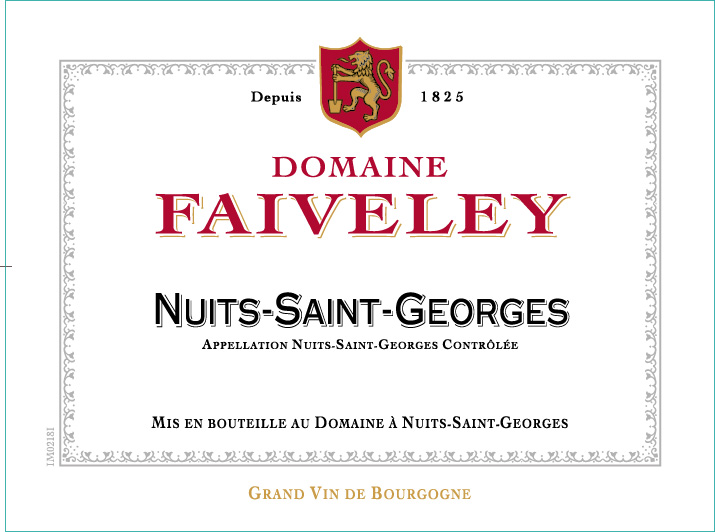

Domaine Faiveley
8, rue du Tribourg
21700 Nuits-Saint-Georges
Tél.: +33 (0)3 80 61 04 55
contact@domaine-faiveley.com
www.domaine-faiveley.com
Domaine Faiveley is located in the heart of the Côte de Nuits, in the village of Nuits-Saint-Georges. Since 1825, the Faiveley family has owned over 120 ha of vines (all converted to organic farming) on exceptional terroirs, including 12 Grands Crus and 25 Premiers Crus. It is the largest winegrowing estate in the entire Burgundy region. This highly respected family has always worked the vines, respecting and serving the climates of the Côte de Nuits, Côte de Beaune and Côte Chalonnaise. Today, representing the 7th generation, Erwan Faiveley and his sister Eve continue to write the finest pages of Faiveley, producer, winemaker, wine-merchant, serving Burgundy's greatest terroirs in a style that combines power, finesse and elegance.
Domaine Faiveley was founded in Nuits-Saint-Georges in 1825 by Pierre Faiveley, a Burgundy terroir enthusiast who initially focused on producing Côte de Nuits wines, but also wanted to set up his own trading company. Pierre Faiveley is a former artisan shoemaker and was therefore not born a winegrower-merchant; This is a unique fact, and a common denominator for each of the generations that follow, first working in another profession or in parallel before joining the family business and the wine trade. In 1860, Joseph Faiveley, son of Pierre Faiveley, took over the reins of the Faiveley estate until his death in 1923. During his tenure, he developed the trading business by exporting wines to Northern Europe, and in 1864 acquired a 3-hectare parcel of land that would become a milestone in the Faiveley family's own holdings: the famous Corton Clos des Cortons Faiveley (integrated with Le Rognet and Corton).
Then it was François Faiveley's turn to get involved in the family business in 1889. At this time, the business was experiencing difficulties concomitant with the phylloxera crisis that ravaged all European vineyards, and Burgundy's vineyards were no exception. Then, the family business turned a corner in the 20s with the arrival of his son Georges Faiveley.
Georges Faiveley is likely to be the generation that will leave its mark on the company, to the point of positively shaking up the economics of Côte de Nuits wines, and perhaps even Burgundy wines more widely. Indeed, under his stewardship of the family business, he was one of the victims of the Great Depression of 1929, the Wall Street crash that shook the global economy for decades to come. From then on, wine stocks piled up in cellars and with merchants, and could no longer be sold. In fact, what can you do in such a situation, when drinking wine has become an expensive pleasure and is far less essential to everyday life? With orders in the company's European markets slowing to a trickle, Georges Faiveley came up with an incredible idea, inspired by a trip to Paris in 1934. The story is significant. The year was 1934. While strolling through the bookshops on the banks of the Seine, Georges Faiveley came across a book on bacchanalian guilds. Curious and interested in the subject, he bought the book. Returning home to Burgundy, Georges discusses the book with his good friend Camille Rodier. It was at this point that he realized that he could simply and generously share his wines around a table with all Burgundy lovers. His stroke of genius: founding a wine brotherhood. The Confrérie des Chevaliers du Tastevin was born. A resurgence of ancient oenophilic brotherhoods, it still carries Burgundy's strong values around the world today. With this initiative, Georges Faiveley has brought about a revival in Burgundy and, of course, in wine consumption, all associated with the strong values of sharing and friendship. A year earlier, Georges took the opportunity to extend the company's field of action by signing a lease for land and plots in the Côte Chalonnaise region, which would later be bought by his son, Guy Faiveley. The creation of this famous brotherhood was therefore a major boost for Domaine Faiveley, enabling it to enjoy an economic revival while acquiring new plots and vinifying in new appellations, thus increasing the range offered by the Faiveley négociant.
His son François, representing the 6th generation, joined the company at the age of 25, in 1976. The company also owes its expansion to him, integrating new plots in new appellations.
While Faiveley's history has traditionally been handed down from father to son, Erwan Faiveley, the 7th generation of the Faiveley family, introduces a new development in the company's history. Arriving in 2005, he took over the reins of the estate and the company, assuming the role of Managing Director, while modernizing the infrastructures, starting with the winemaking facilities (renovation of the Mercurey fermenting room then in 2018 of the magnificent Eiffel-style vat room in Nuits-Saint-Georges), while also extending the scope of action to other appellations (acquisition of parcels in 2008 in white Grands Crus in Bâtard-Montrachet and Bienvenue-Bâtard-Montrachet) to a first venture into American vineyards, in California, with a stake in William Selyem. The new event we were talking about is the arrival of a woman in the company's destiny: Eve Faiveley. Erwan's sister, Eve joined her brother in 2014 to jointly manage the company. Initially in charge of communications and marketing, Eve is now in charge of the sales network for the French market and some export areas. This close-knit duo adds a new dimension to the history and development of the Faiveley estate, while continuing to serve the know-how and tradition carried on valiantly and brilliantly by their predecessors. With the determined intention of ensuring the company's long-term future, while pursuing new projects and “modernizing” the style of their wines (perhaps more in line with consumer expectations for more expressive Burgundies that can be drunk young, without sacrificing their capacity for ageing and improvement), Erwan and Eve are indeed the worthy successors of their forebears. 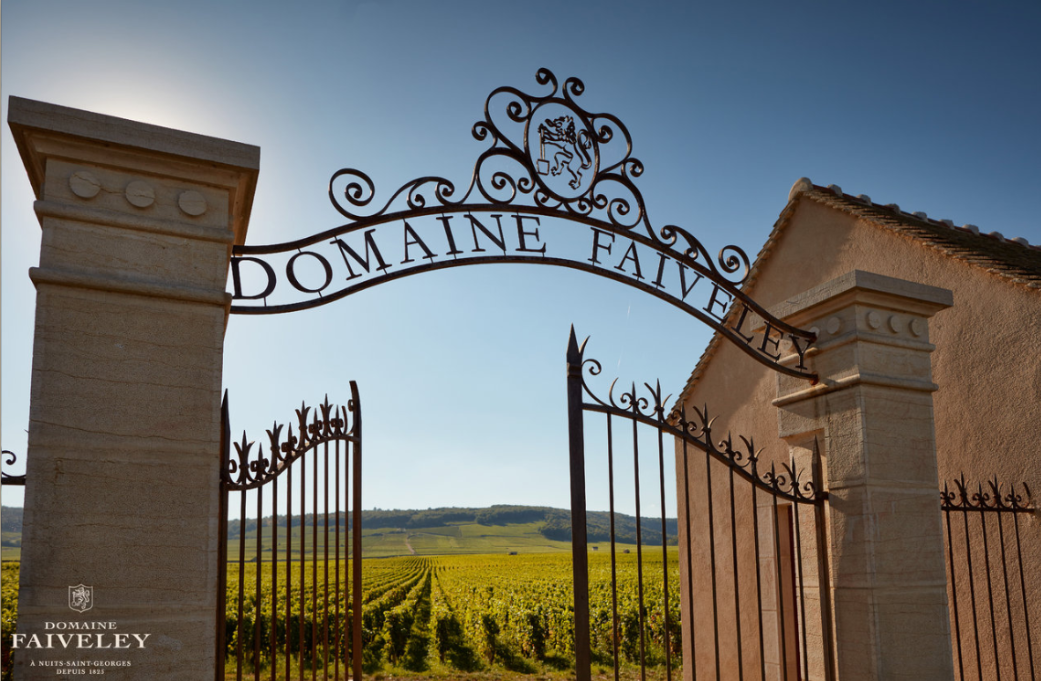
Domaine Faiveley is currently the largest winegrowing estate in the Côte d'Or, with around 160 hectares of vines, i.e. 300 distinctive plots. Its vineyards are found in renowned climates and appellations in Côte de Nuits (its historic stronghold), Côte de Beaune, Auxerrois (Chablis) with the 2014 acquisition of Billaud-Simon) and Côte Chalonnaise. The historic center of Nuits-Saint-Georges, the villages of Gevrey-Chambertin, Pommard, Volnay, Puligny-Montrachet and Mercurey are all part of its radius of action.
Domaine Faiveley's reputation is built on Grands Crus (10 hectares) and Premiers Crus (around 30 hectares) in Gevrey-Chambertin, Chambolle-Musigny, Clos de Vougeot, Corton and Nuits-Saint-Georges, and with owns three Monopoles: Gevrey-Chambertin Premier Cru Clos des Issarts, Corton Clos des Cortons Faiveley Grand Cru and Beaune Premier Cru Clos de l'Ecu. Faiveley is also owner of three other Monopoles in Côte Chalonnaise: Premier Cru Mercurey Clos des Myglands Monopole, Village Mercurey Clos La Rochette Monopole and Village Mercurey Clos La Framboisière Monopole. Faiveley is also present in Corton-Charlemagne, in short in all the major Burgundy appellations.
To vinify all these marvels and manage such a wide variety of viticultural situations and appellations (and wines), Domaine Faiveley has two wineries (fermenting rooms), enabling it to plan harvest arrivals according to the geographical areas concerned and carry out parcel-based vinifications.
Then, Faiveley can count on its teams, led since 2007 by the company's Technical Director, Jérôme Flous, and on two vat rooms at the cutting edge of innovation and two cellars able to manage grapes and wines according to the hierarchy and level of zones and quality. One is in Nuits-Saint-Georges and the other in Mercurey on the Côte Chalonnaise. The Mercurey winery, inaugurated in 2015, is used to vinify parcels in Mercurey, Maranges, Givry and Rully. The other winery on the Côte de Nuits is mainly used to vinify and mature Grands Crus from the Côte de Beaune and Côte de Nuits. This winery was renovated in 2018 and, like the Mercurey winery, is equipped with all-gravity, thermoregulation systems, and boasts a splendid setting whose framework is reminiscent of the Eiffel style. It's worth remembering that the famous French architect who designed the Eiffel Tower, among other things, was a Burgundian, hailing from the town of Dijon. This cutting-edge equipment has contributed, under the influence of management's willingness to explore other approaches, to modifying the style of our house wines, which used to be more massive, more concentrated and more geared to ageing, but have now become more greedy, more accessible in their early years, although this does not prevent us, depending on the vintage, from offering wines for ageing, particularly in the Grands Crus and Premiers Crus. 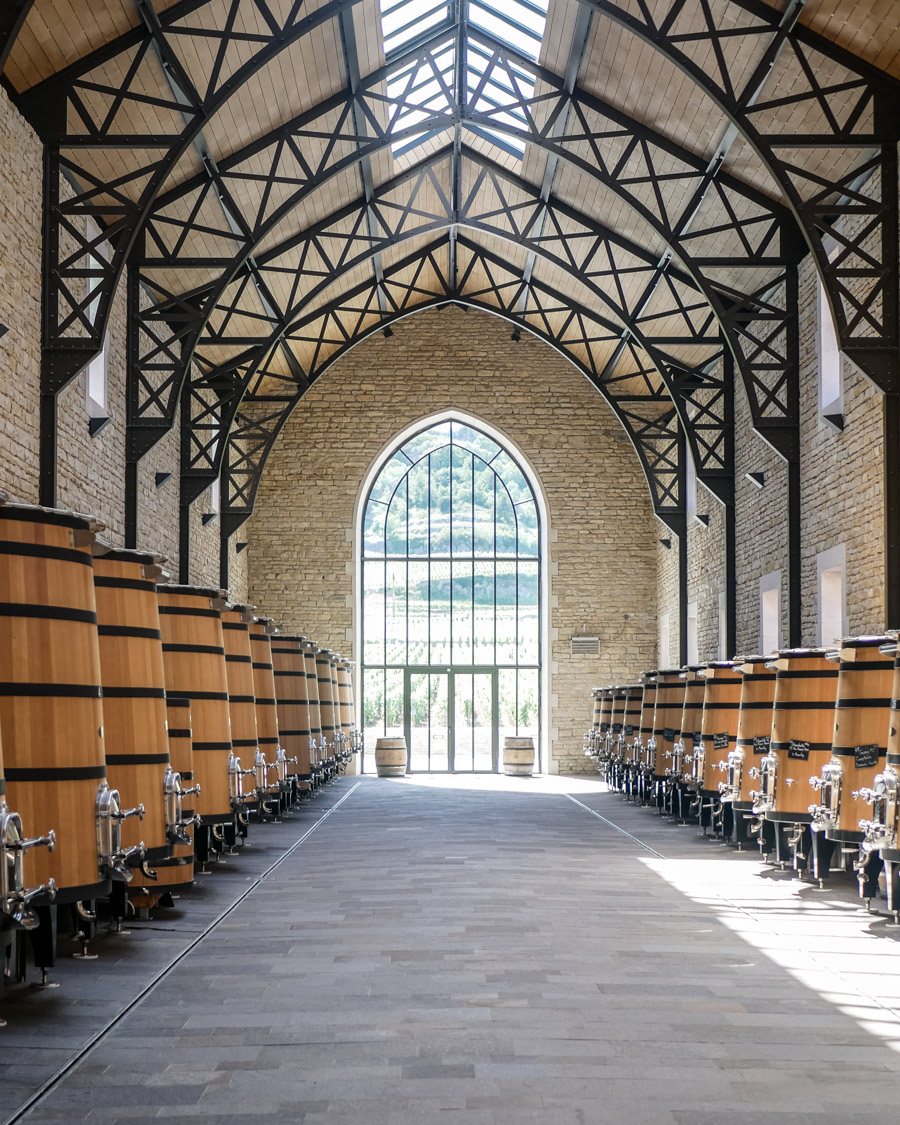
The wines from the 300 plots managed by Faiveley have a common denominator, so to speak, at least since 2007: more precise, fine, gourmet wines with purity of fruit and easier, more accessible appreciation in their youth. But more than that, they come from a viticulture more in line with the environmental objectives set by Erwan Faiveley and his teams. Indeed, since July 2022, the entire Faiveley estate has gone over to organic viticulture (the vines will be AB certified in 2025), the fruit of a long process of reflection that is not simply motivated by ever-increasing consumer demand for organic wines, but by conviction. Among the Faiveley, as in many other Burgundy estates, the use of chemicals in conventional cultivation soon revealed its limitations. Erwan and Eve's father, François Faiveley, had already taken the Faiveley estate a step further by adopting a “lutte raisonnée” approach. But the children went even further, deciding to convert 120 hectares (the entire estate) to organic farming, making Faiveley the first estate in terms of surface area to go organic. Currently, one third of the estate is farmed organically, while the remaining two thirds are HVE 3 certified.
To get the full measure of Faiveley's style, the choice of wines is vast, even among the Grands Crus and Premiers Crus. So let's talk about emblematic wines (of which there are many) or exclusive wines or in-house “Monopoles”. How could we fail to mention a rarity, the Grand Cru Corton Clos des Cortons Faiveley Monopole in Côte de Beaune (the only red Grand Cru in Côte de Beaune), or even the Grand Cru Chambertin-Clos de Bèze “Les Ouvrées Rodin” in Côte de Nuits, or further south, in Côte Chalonnaise, the Premier Cru Mercurey Clos des Myglands Monopole, or in Village, the Mercurey Clos Rochette Monopole and its neighbor, Mercurey La Framboisière Monopole.
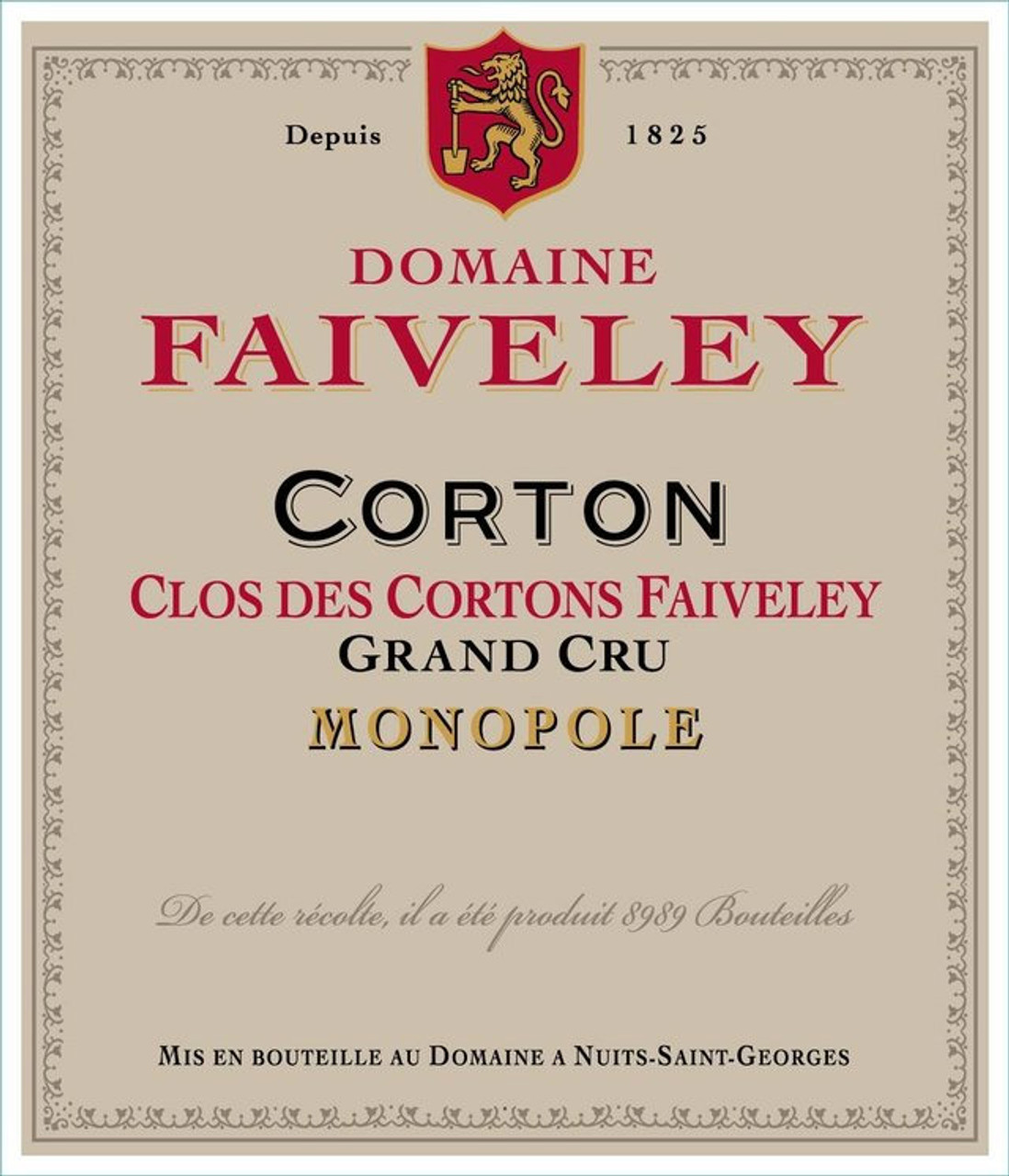
This 2.76-hectare plot, acquired in 1874 by the Faiveley family, is emblematic and its wine is the flagship of Maison Faiveley as a winegrowing estate. The wine's style owes much to the diversity of Corton's soils: more limestone on the higher ground (a 300-meter-high hill), more ferruginous with heavier red soil on the lower ground. The result is a wine that is straightforward, mineral, powerful yet elegant, fine and deep. The nose displays rich, intense aromas of red fruits mixed with spices. The palate is reasonably serene and very well balanced. A great Corton and a wine for laying down par excellence.
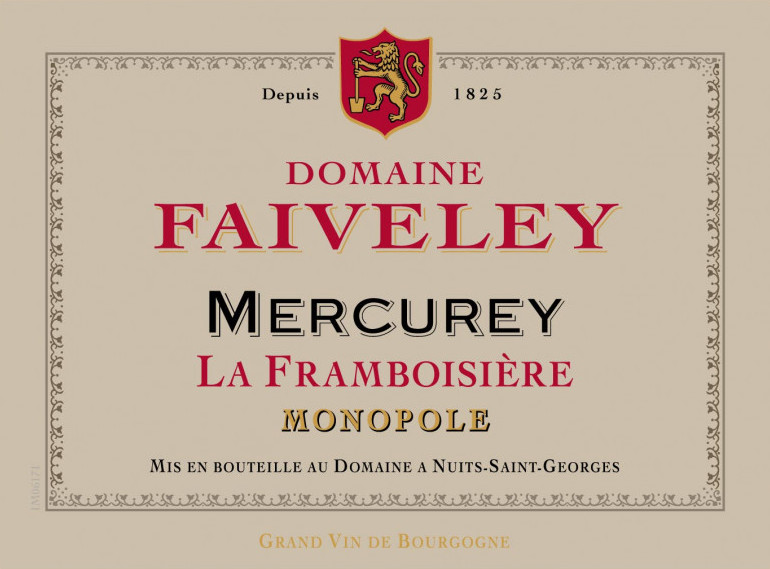
Neighboring the Clos Rochette parcel, Faiveley's other Monopole in Mercurey Village, Mercurey La Framboisière Monopole is an 11-hectare 11 parcel purchased in 1933. Why the name “La Framboisière”? Simply by the presence of raspberry plants on the premises. The nose is highly aromatic, with intense notes of wild berries and red fruits, including raspberry. The palate is greedy and fruity, with beautifully smooth tannins. A gourmet wine and a perfect image of the best of the Côte Chalonnaise.
Red wines : 1959, 1961, 1964, 1966, 1971, 1976, 1978, 1985, 1986, 1989, 1990, 1993, 1995, 1996, 1997, 1998, 1999, 2002, 2003, 2005, 2007, 2009, 2010, 2014, 2015, 2016, 2017, 2018, 2019, 2020, 2021, 2022.

Website under construction
Available Soon